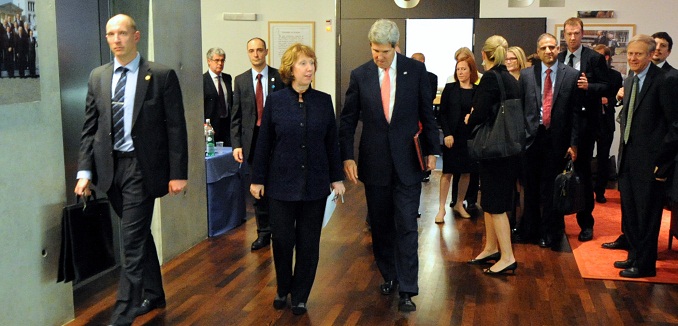With speculation over impending Iran talks reaching a fever pitch, analysts are outlining what minimum requirements an interim deal with Iran must meet if it is to successfully move Tehran further from being able to construct a nuclear weapon. At stake more precisely is whether Iranian concessions – to be made in exchange for sanctions relief – will meet President Barack Obama’s stated goal of ensuring that, during an interim period of six months, the Iranians are “not busy advancing their program.”
Yesterday Orde Kittrie – a senior fellow at the Foundation for Defense of Democracies and a tenured professor of law at Arizona State University’s Law School – evaluated a deal that was almost struck two weeks ago during previous talks would have secured that goal. The agreement reportedly would have allowed Iran to continue constructing centrifuges, continue enriching uranium, and continue bolstering its plutonium-producing complex at Arak. The result would have fallen “far short of what the President set as the goal of this phase-one deal,” with Iran ending up closer to both uranium and plutonium nuclear bombs than it is today:
The draft interim agreement reportedly fails to require Iran to suspend enrichment of uranium to 3.5 percent. It also reportedly places no constraints on Iran’s continued manufacturing of centrifuges. The draft interim agreement would thus enable Iran to, at the end of the six month interim agreement period, possess both a larger stockpile of uranium enriched to 3.5 percent and a larger number of manufactured centrifuges than it does today. These advances would put Iran in position to much more quickly produce far more weapons grade uranium than it can today. Tehran would be significantly closer to the point at which it is able to dash to produce enough weapons-grade uranium for one bomb so quickly that the IAEA or a Western intelligence service would be unable to detect the dash until it is over…
Similarly dangerous gaps are present in the draft interim deal’s handling of Iran’s heavy water reactor at Arak and Iran’s research into nuclear weapons design. The draft interim deal reportedly includes Iran continuing construction of its heavy water reactor at Arak, while committing to not bring it online for the duration of the six month interim deal period. By continuing construction of the Arak heavy water reactor, even with a commitment not to produce additional fuel assemblies for six months, Iran will continue to advance towards creating plutonium.
Kittrie described the contours of a deal that actually would secure the President’s goal:
With regard to enrichment, if the interim agreement is to make “absolutely certain that while we’re talking with the Iranians, they’re not busy advancing their program,” it should… halt all Iranian enrichment; verifiably prohibit Iran from manufacturing additional centrifuges; require Iran to adhere to the Additional Protocol; and require Iran to accept and immediately and verifiably implement its existing legal obligation to notify the IAEA of any enrichment or other nuclear facility it possesses or begins constructing… The only way to make “absolutely certain that while we’re talking with the Iranians, they’re not busy advancing their program” at Arak is for Iran to verifiably halt all construction, as Iran is already required to do by several UN Security Council resolutions.
Kittrie’s emphasis on prohibiting centrifuge manufacturing echoes that of by the U.S.-based Institute for Science and International Security. The new centrifuges that Iran was building during the interim period could be installed at the end of it. The boost in enrichment capacity provided by the new centrifuges would swamp whatever concessions Iran had made over the previous six months: if Tehran had given up portions of its enriched stockpile, for instance, Iran scientists would then be in a position to quickly make up for lost time.
[Photo: U.S. Department of State / Flickr]




